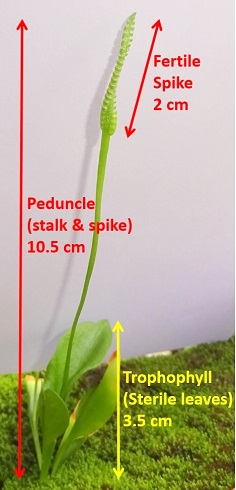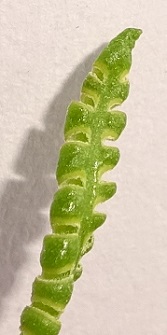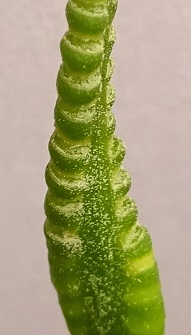| Home | Nature Weekly Index |
24 July 2016 | Tongue Fern | Ophioglossum reticulatum |
 The Tongue Fern (Ophioglossum reticulatum) in my pot that I
shared about a year back was still doing well. In fact, it had
a few more leaves now. With the fern around, I had removed most of the
Hippobroma longiflora (Star of Bethlehem) in the pot to make
sure that they kept a distance away from the fern. Also, I observed that the Hippobroma longiflora was causing stress
to the Malpighia glabra (Barbados Cherry) in the same pot. At least 3
Andrographis paniculata (King of Bitters) were now growing in
the pot. Unlike Hippobroma longiflora, King of Bitters had very shallow root system and did not appear to threaten
the Barbados Cherry plant.
The Tongue Fern (Ophioglossum reticulatum) in my pot that I
shared about a year back was still doing well. In fact, it had
a few more leaves now. With the fern around, I had removed most of the
Hippobroma longiflora (Star of Bethlehem) in the pot to make
sure that they kept a distance away from the fern. Also, I observed that the Hippobroma longiflora was causing stress
to the Malpighia glabra (Barbados Cherry) in the same pot. At least 3
Andrographis paniculata (King of Bitters) were now growing in
the pot. Unlike Hippobroma longiflora, King of Bitters had very shallow root system and did not appear to threaten
the Barbados Cherry plant.

 The above-ground part of the fern consists of the sterile leaves which also go by the names trophophyll and trophophore.
When the fern matures, a long erected fertile stalk extended from the leaf stalk. This fertile stalk also goes by the names
peduncle or sporophore. At the distal end of the peduncle houses the slightly twisted spike or strobilus where the
sporangia lined up in pairs along the length. The estimated lengths of the various parts were illustrated in the picture.
The current fern was much taller than the one seen last year although the current one grew from exactly the same spot where
the old one was. The drastic reduction of the Hippobroma longiflora population had likely given a boost to the fern
which had been competing with this flowering plant in the past. The rhizome of the fern was situated underground and covered
by the carpet of mosses. With the one and only fern in the pot, I was not ready to pull it for the purpose of examining its
underground parts.
The above-ground part of the fern consists of the sterile leaves which also go by the names trophophyll and trophophore.
When the fern matures, a long erected fertile stalk extended from the leaf stalk. This fertile stalk also goes by the names
peduncle or sporophore. At the distal end of the peduncle houses the slightly twisted spike or strobilus where the
sporangia lined up in pairs along the length. The estimated lengths of the various parts were illustrated in the picture.
The current fern was much taller than the one seen last year although the current one grew from exactly the same spot where
the old one was. The drastic reduction of the Hippobroma longiflora population had likely given a boost to the fern
which had been competing with this flowering plant in the past. The rhizome of the fern was situated underground and covered
by the carpet of mosses. With the one and only fern in the pot, I was not ready to pull it for the purpose of examining its
underground parts.
There were about 19 pairs of sporangia on this particular spike. Fine and white powdery particles could be seen on the surface of the spike which I suspected might be the spores. The ripening of the sporangia appeared to take place starting from the tip and work its way down the base of the spike.
The Tongue Fern that I saw in the past in the park and beside walkways had heart-shaped leaves while the one in my pot had elongated leaves. My current deduction of it identity was based on the count of paired sporangia. The latest published reference found was a 2009 article.
The Fern of Thailand website, indicated that Ophioglossum reticulatum auct. non as a misapplied name of Ophioglossum petiolatum. The length of the sporophyll was stated as 6-12 cm while that of the spike was 1.5-4.5cm. But there was no mentioned of the paired sporangia count on the spike. Potentially, this fern might be Ophioglossum petiolatum.